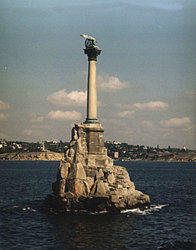| THE MONUMENT TO SCUTTLED SHIPS | Sevastopol.org |
 The Monument to the scuttled ships of the Black Sea Fleet is located in the Sevastopol Bay, 10 meters away from the seafront of the Seaside Boulevard.
It was built in 1905 on the fiftieth anniversary of the first heroic defense of Sevastopol after the design of sculptor A.G. Adamson, architect V.A. Feldman with the participation of the military engineer colonel O.I. Enberg.
The Monument to the scuttled ships of the Black Sea Fleet is located in the Sevastopol Bay, 10 meters away from the seafront of the Seaside Boulevard.
It was built in 1905 on the fiftieth anniversary of the first heroic defense of Sevastopol after the design of sculptor A.G. Adamson, architect V.A. Feldman with the participation of the military engineer colonel O.I. Enberg.
To bar the entrance to the harbor for the naval ships of England, France and Turkey during the Crimean War and the first defense of Sevastopol, two rows between the Konstantinovskaya and Alexandrovskaya batteries and later between the Mikhailovskaya and Nikolayevskaya batteries were filled in the course of defense with 15 scuttled naval ships of the Black Sea Fleet : Ships of the Line including" The TwelveApostles", "Svyatoslav", "Rostislav", "Gabriel", "Silistria", "Varna", "Uriel", "Selathael", "Three Holy Men"and Frigates "Flora", "Sizopolis", 'Kagul", "Mesemvria", "Midia" plus Corvette "Pylades".
After removing guns from the ships, the crews took part in defending Sevastopol at the bastions.
The Monument consists of the artificial granite cliff made up of rough boulders standing on a square base (9.2 x 9.2m). A hexahedral pedestal rises from the cliff and it is crowned with a Corinthian column of light-colored diorite. On top of it there is a bronze sculpture of the two-headed eagle with widespread wings facing the sea, which holds in its beak the laurel wreath of glory and the naval anchor. Lower on the cliff, the bronze mast of the sailing- ship is attached. On the side of the pedestal facing the seafront there is a memorial plaque with the relief map of the Sevastopol harbor and marked areas where the ships were scuttled.
The total height of the Memorial is 16.66 m.
During the Great Patriotic war the Monument was damaged and restored in 1961. The Monument is an integral part of the memorial complex created to mark the 50th anniversary of the liberation of Sevastopol under the supervision of architect A.M. Veisen and is one of the symbols of the Hero City of Sevastopol.
